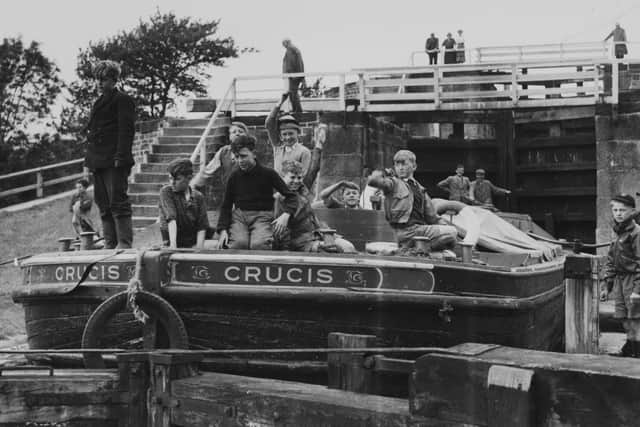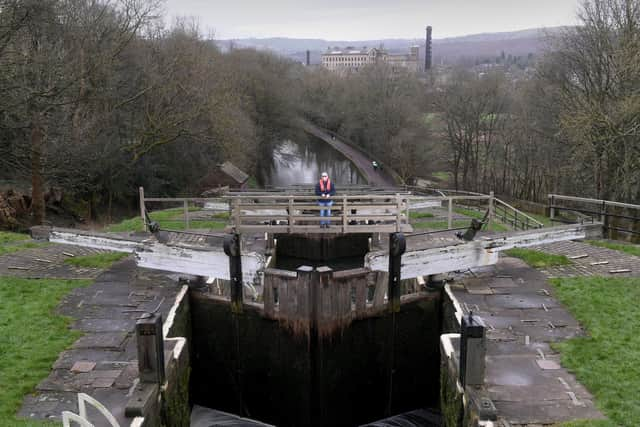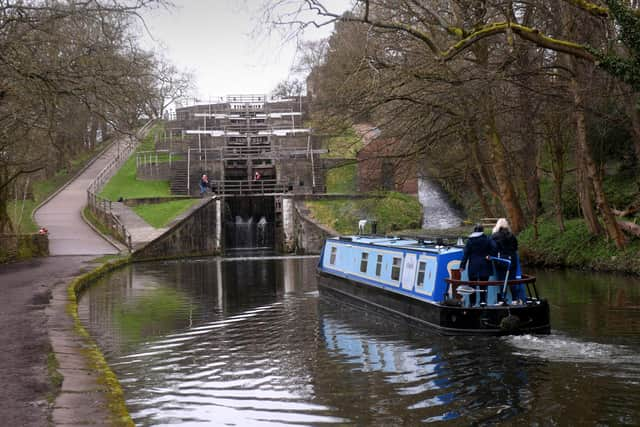Bingley Five Rise Lock: The incredible history of an iconic piece of engineering
A gongoozler is a person who enjoys watching activity on the British canals. A bit like a towpath trainspotter, if you like, but instead of just being fascinated by trains and rolling stock, gongoozlers are interested in everything in, on, or by the canal and its people. All of a canal’s many aspects.
The Canal and River Trust looks after around 2,000 miles of the UK’s canals and navigable rivers, and has been doing that since 2012. It’s the largest and finest example of industrial heritage in the world, but it also meanders through some of our finest countryside.
Advertisement
Hide AdAdvertisement
Hide AdThe Leeds and Liverpool Canal is the longest of them all, a total of 127 miles, from Neville Street in the heart of Leeds, to Canning Dock, on the West coast. In Yorkshire, the canal flows through Kirkstall, Keighley, Skipton and then on to Bank Newton, where it crosses the border. There are several branches along the way and 91 locks. Construction began in 1770, and it wasn’t completed until 1816.


Strictly speaking the first sod was cut in Halsall, just north of Liverpool, but the first truly working section was from Skipton to Shipley, in 1774. People of the day could wonder at the beauty of the seven-arch aqueduct over the River Aire at Dowley Gap, but the very best achievement was undoubtedly the eight locks at Bingley – the Three Rise and the “bigger sister”, the famed and Grade I listed, Five Rise.
This month, they celebrate a remarkable 250 years of service. Technically, the Five Rise is five ‘staircase’ locks, connected one to the other without intermediate ‘ponds’, and the lower gate of each ‘chamber’ forms the upper gate of the one below – which means that there are five chambers, and six gates. They are just over 14ft wide. It’s the steepest flight of locks in the UK, with a rise of nearly 60ft over a distance of 320ft.
The intermediate and bottom gates are the tallest in the country, and when it was opened on March 21, 1774, 30,000 people turned up to celebrate. It has been a favourite spot for gongoozlers ever since.
Advertisement
Hide AdAdvertisement
Hide AdOne of today’s volunteer lockkeepers is Philippa Gibbons – she is also Chair of Bingley Town Council. She’s beginning her fourth season with Canal and River Trust, and she is still in awe of the Five Rise, which she calls “the eighth wonder of the world”. Philippa knows the place like the back of her hand, and lives nearby, but, strangely enough, she’s never ever been up or down it on any sort of boat.


However, she has seen it from a very different viewpoint – she’s one of the very few people who have been in it. She walked the entire system when it was drained in 2012 when new lock gates of English green oak were installed, and the engineers had to manoeuvre well over five tonnes into position. When Philippa is working at the Five Rise, and in the height of the season, she reckons that she’ll put in about 25,000 steps a day “so in effect, it becomes my own outdoor gym.”
She smiles as she reveals that, if a boat goes through, “it tends to be the ladies who do all the hard work. They’re the ones who get onto the towpath, and who open and close the gates. The men, by and large, are the ones who apply themselves to the steering.
“Why? My theory is that a lot of the women don’t like to be ‘trapped’ in a lock as the boat rises or fall, they find it a bit claustrophobic. Any animals on board don’t like the experience very much either. I can understand that very well, because I’ve been right at the bottom, looking up – an unforgettable experience. The second chamber is the deepest of them all.
Advertisement
Hide AdAdvertisement
Hide Ad“It’s really rather special to know that I am part of something that has evolved over the years. It’s amazing that it is still here, doing what it was designed to do, and that it has a great future. It’s such a pleasure to talk to a huge range of people, from all walks of life – some want to have a good long chat, other just give a wave and a smile, and they come from all over the world. I’ve met Australians, New Zealanders and Japanese – there was even a big group of American girl scouts.”


Philippa worked in IT project management until retiring at the end of the lockdown period. “I think that I just got rather weary of conference and zoom calls. I’m a person who likes to meet people, not watch them on a screen.”
Lock-keeping, it seems, isn’t just keeping your eye on the canal traffic, but on those gongoozlers as well. “Some people do manage to stand in precisely the wrong place to watch what goes on, and you have to patiently explain why they must move from here, to over there.” And if there are quiet moments, Philippa and her colleagues don’t sit quietly to enjoy a nice brew.
“There’s an awful lot of maintenance to be done, like mowing the lawns and trimming the nearby hedges”, she says, “and I seem to get all the painting jobs. I absolutely love the life, there’s a wonderful view from my ‘office’, that’s for sure !” She’s also a keen motorcyclist and kayaker – “there aren’t many empty moments in my day”, she smiles.
Advertisement
Hide AdAdvertisement
Hide AdSean McGinley is the Regional Director of the Trust. “We simply couldn’t function without the incredible input of people like Philippa. But the funny thing is that we really don’t advertise the positions of volunteer – it’s a word-of-mouth thing.”
A civil engineer by profession, Sean has been with the organisation for 21 years and he oversees all of Yorkshire’s canals, from one end of the Chesterfield Canal to those in Ripon and Stockton. There are about 100 full-timers, and well over 500 volunteers to be called on. He too wonders how the canal, and the rises, were created in the first place.
“Think about it – no tractors, no cranes, no earth-shifting equipment, just men with shovels and maybe a few horses and carts. If they needed bricks, they built a small factory nearby, and used the local clay, if it was suitable. If they needed stone, they got it from a quarry – and probably dug the quarry by hand as well. It must have been a back-breaking existence, and they were out in all weathers, being paid a pittance”.
Ruth Garrett is Heritage Advisor for the Trust, and she reveals that there are few original documents in the archives which tell of the design of the Five and Three Rises. In fact, the basic principles of a lock system were drawn in the notebooks of Leonardo da Vinci. It was the nimble brain of the Georgian engineer John Longbotham who made them into functioning fact.
Advertisement
Hide AdAdvertisement
Hide Ad“He devoted much of his life and career to the Leeds and Liverpool,” she says, “but there were a lot of obstacles along the way, and by 1800 the poor man was in poverty and wrote a tactful letter to the company who had used his talents, asking for some sort of pension. They took so long to reply that, when their response was delivered to his house in 1801, they found that he had died some months before! They generously agreed to pay for his funeral.
“That aside, I really do think that he’d be so pleased that his great contribution to the North was still very much a part of the working landscape, both industrial and rural, that it was part of Yorkshire’s heritage and also, with the many thousands of visitors that it gets every year, very much part of its future, as well”
Canal & River Trust is commemorating the 250th anniversary of the Grade I Listed Bingley Five Rise Locks and Grade II* Listed Bingley Three Rise Locks on the Leeds & Liverpool Canal in Yorkshire with a special event on Saturday 23 March, 10am – 3pm.
Comment Guidelines
National World encourages reader discussion on our stories. User feedback, insights and back-and-forth exchanges add a rich layer of context to reporting. Please review our Community Guidelines before commenting.